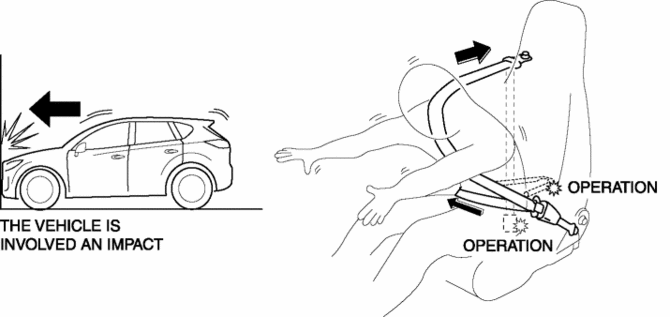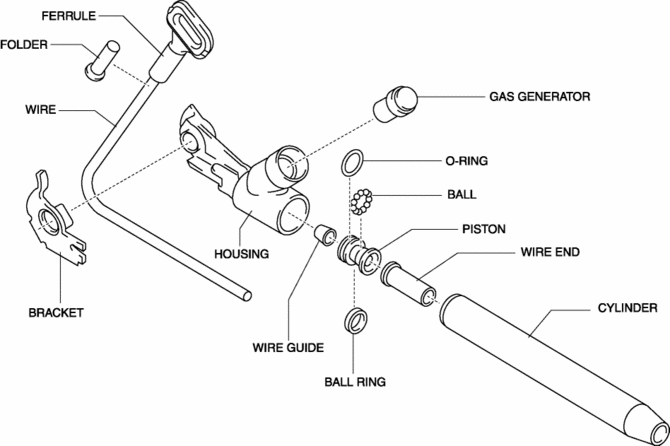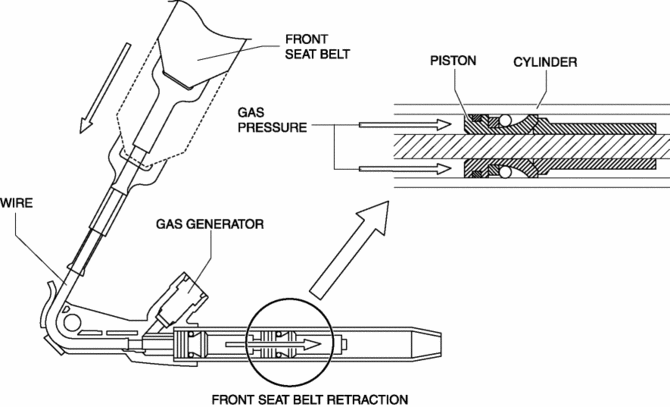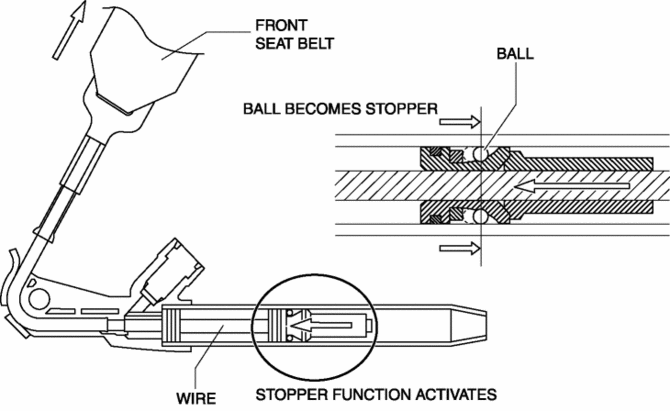Mazda CX-5 Service & Repair Manual: Lap Pre Tensioner Seat Belt [Two Step Deployment Control System]
Purpose
-
The lap pre-tensioner seat belts retract and tighten the seat belt webbing to protect the front passengers during a collision.
Function
-
The lap pre-tensioner seat belts operate (deploy) based on the operation signal from the SAS control module to instantly retract and tighten the belt webbing, restraining the driver.
-
The lap pre-tensioner seat belts operate in conjunction with the pre-tensioner seat belts.

Construction
-
The lap pre-tensioner seat belts are installed to the anchors of the front seat belts.
-
The lap pre-tensioner seat belts consist of the following parts shown in the figure:

Operation
Lap pre-tensioner activation
1. The gas generator emits a spark when a signal is received from the SAS control module, causing gas to form.
2. The gas pressure pushes the piston inside the tube, pulling the lead wire.
3. As the lead wire is pulled, the part of the seat belt attached to the wire is also pulled.
4. The slack in the belt is tightened by the front seat belt being pulled by the lap pre-tensioner seat belt and the seat belt ELR mechanism, restraining the passengers.

After activation
1. After operating (deploying) the pre-tensioner, the lead wire is pulled back. However the front seat belts are locked by activation of the stopper function so that the belt webbing is not released.
2. The restraint force of the seat belt is adjusted by the front seat belt load limiter mechanism, preventing injury to the driver and passenger from seat belt pressure.

Fail-safe
-
Function not equipped.
 Front Seat Belt Removal/Installation
Front Seat Belt Removal/Installation
WARNING:
Handling the front seat belt (pre-tensioner seat belt) improperly can accidentally
deploy the pre-tensioner seat belt, which may seriously injure you. Read the
air bag system se ...
 Pre Tensioner Seat Belt [Standard Deployment Control System]
Pre Tensioner Seat Belt [Standard Deployment Control System]
Purpose
The pre-tensioner seat belt retracts and tightens the seat belt webbing to
protect the front passengers during a collision.
Function
The pre-tensioner seat belts operate ...
Other materials:
Floor Under Cover Removal/Installation
1. Lift up the vehicle.
2. Remove bolts A.
3. Remove fasteners B.
4. Remove the floor under cover No.1.
5. Remove nuts C.
6. Remove fasteners D.
7. Remove bolts E.
8. Remove the floor under cover No.2.
9. Remove bolts F.
10. Remove the fastener G.
11. Remove the floor ...
Engine Coolant Temperature (ECT) Sensor Inspection
Resistance Inspection
WARNING:
When the engine is hot, it can badly burn. Turn off the engine and wait until
it is cool before removing the ECT sensor.
ECT Sensor No.1
1. Remove the ECT sensor No.1..
2. Place the ECT sensor No.1 in water with a thermometer, and heat the water
...
Variable Valve Timing Mechanism
Outline
Achieves optimum valve timing according to the driving conditions by the
variable valve timing mechanism changing the phases of the camshaft.
An electric type variable valve timing mechanism on the intake side and a
hydraulic pressure type on the exhaust side has been ad ...
